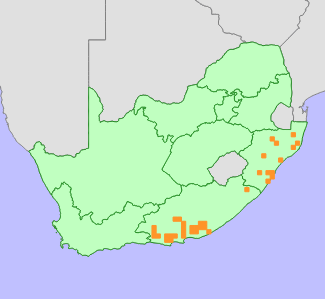L. meisnerianus has a disjunct distribution, with two widely separated areas of occurrence. It was described from the vicinity of the Great Fish River in the Eastern Cape (Meisner 1840), where the species is associated with Albany Thicket, and occurs from the Baviaanskloof to Somerset East and Peddie. Then there are numerous collections from KwaZulu-Natal, but the species appears to be absent from the eastern parts of the Eastern Cape. The genus Lasiosiphon is in need of revision, and species are difficult to identify. It is possible that the KwaZulu-Natal records may represent a separate taxon.
|
Boon, R. 2010. Pooley's Trees of eastern South Africa. Flora and Fauna Publications Trust, Durban.
Goldblatt, P. and Manning, J.C. 2000. Cape Plants: A conspectus of the Cape Flora of South Africa. Strelitzia 9. National Botanical Institute, Cape Town.
Manning, J.C. and Goldblatt, P. 2012. Plants of the Greater Cape Floristic Region 1: The Core Cape Flora. Strelitzia 29. South African National Biodiversity Institute, Pretoria.
Meisner, C.F. 1840. Synopsis Thymelaearum, Polygonearum et Begoniarum Africae Australis. Linnaea 14:385-502.
Pooley, E. 2005. A field guide to wild flowers of KwaZulu-Natal and the Eastern Region. Natal Flora Publications Trust, Durban.
Raimondo, D., von Staden, L., Foden, W., Victor, J.E., Helme, N.A., Turner, R.C., Kamundi, D.A. and Manyama, P.A. 2009. Red List of South African Plants. Strelitzia 25. South African National Biodiversity Institute, Pretoria.
Wright, C.H. 1925. Thymelaeaceae. In: W.T. Thiselton-Dyer (ed). Flora Capensis V Section II (Thymeleaceae-Ceratophylleae):1-81. L. Reeve & Co., Ltd., Ashford.
|
 Comment on this assessment
Comment on this assessment

